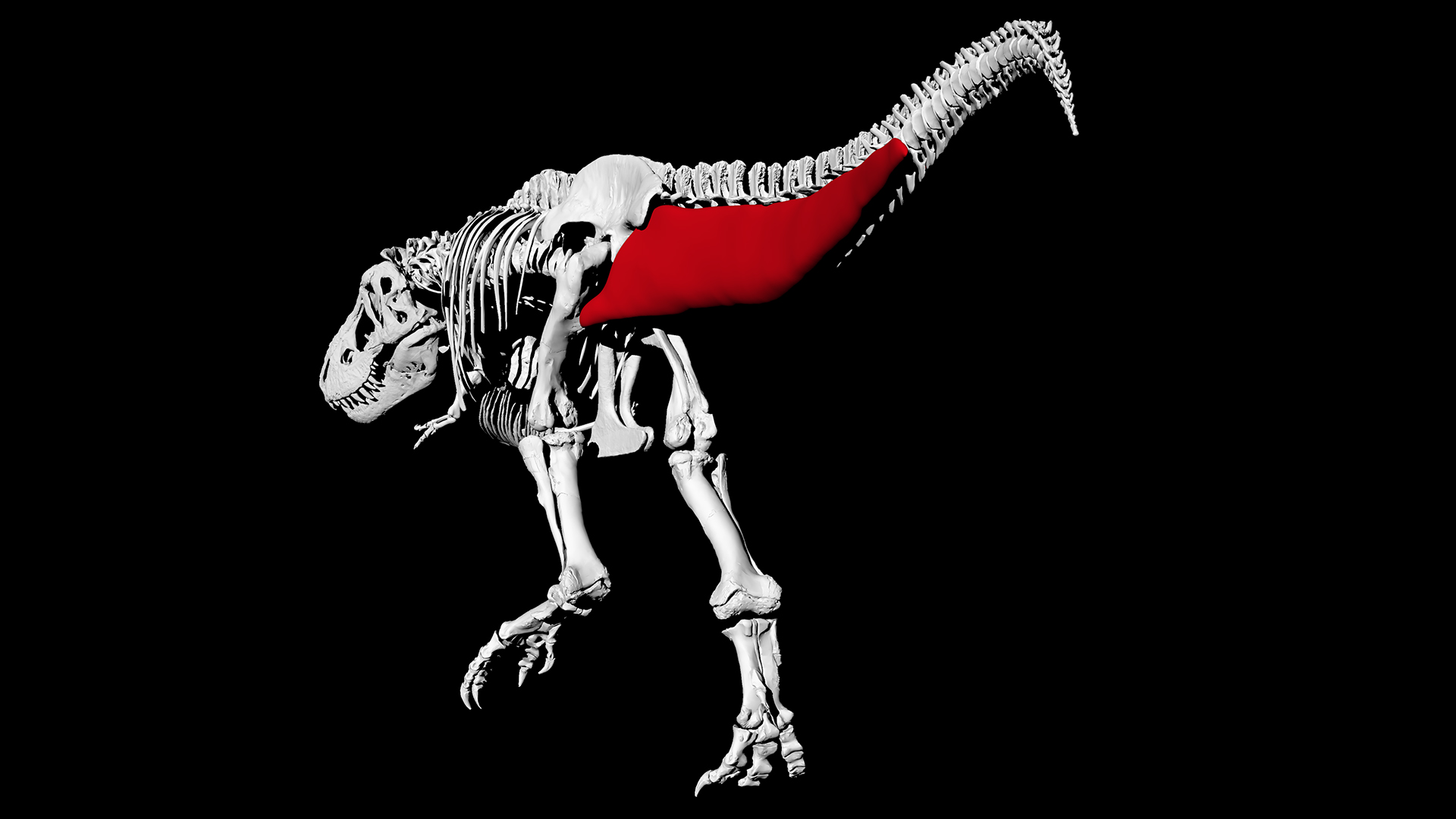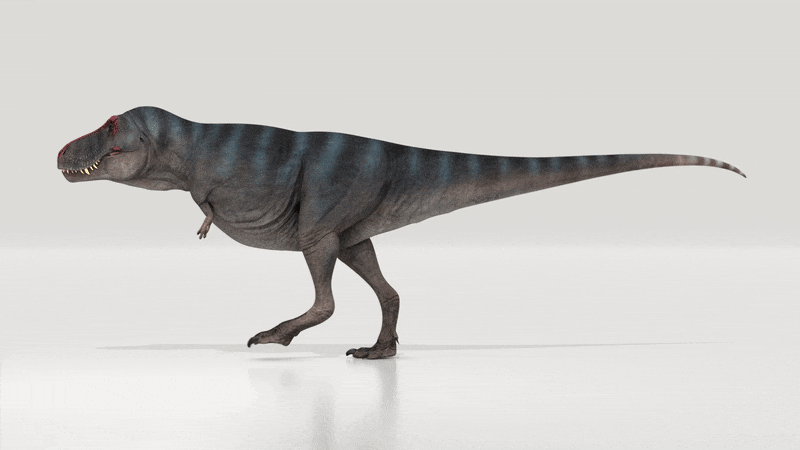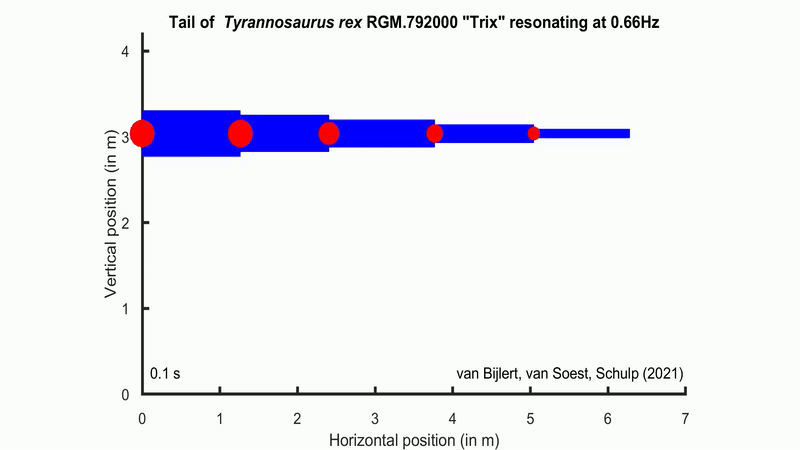Never mind outrunning a T. rex — you could probably outwalk it
New simulations calculated T. rex walking speed from the motion of its swaying tail.

Could you run faster than a T. rex? According to new research, you might be able to outpace one by walking.
In the movie "Jurassic Park" (Warner Bros, 1993), a carful of terrified people famously tries to escape a loping T. rex, but science quickly threw shade at the movie beast and demonstrated that the king of tyrannosaurs wouldn't have been fast enough to run down a jeep. Now, researchers have slowed down the big dinosaur even more.
New simulations based on tail movement showed that T. rex wasn't even a quick walker. In fact, its preferred walking speed clocked in at just under 3 mph (5 km/h), about half the speed of earlier estimates. To put that into perspective, that's about the average walking speed for a human, according to the British Heart Foundation.
Related: Image gallery: The life of T. rex
Tyrannosaurus rex, the biggest of all carnivorous dinosaurs, lived in what is now the western United States, from about 66 million to 68 million years ago toward the end of the Cretaceous period, and they likely numbered in the billions.
An adult T. rex would have measured about 40 feet (12 meters) long, stood 12 feet (3.6 m) tall and weighed about 11,000 to 15,500 pounds (5,000 to 7,000 kilograms) on average, according to the American Museum of Natural History in New York City. The heaviest known T. rex, a hefty specimen found in Saskatchewan, Canada, and nicknamed "Scotty," weighed in at a whopping 19,555 pounds (8,870 kg), Live Science previously reported.
But how fast could such a big animal move? Previously, researchers answered that question by looking at T. rex's mass and hip height, sometimes incorporating stride length from preserved trackways. Those estimates placed a T. rex's walking speed roughly between 4.5 and 6.7 mph (7.2 and 10.8 km/h), about as fast as a mediocre human runner.
Sign up for the Live Science daily newsletter now
Get the world’s most fascinating discoveries delivered straight to your inbox.
For the new investigation, rather than focusing on T. rex's legs, scientists instead explored the role played by the vertical movement of the tyrannosaur's tail, said Pasha van Bijlert, a master's candidate studying paleo-biomechanics at the Free University of Amsterdam, and the lead author of the new study on T. rex walking speed.
"Dinosaur tails were vital to the way they moved around, in multiple ways," van Bijlert told Live Science in an email. "Not only does it serve as a counter balance, the tail also produces a lot of the required force to move the body forward. It does this through two large tail muscles — the caudofemoral muscles — that pull the legs backwards during each step."

Passive and active
In the bipedal (two-legged) T. rex, the tail would have been passively suspended in the air but also actively engaged and naturally swaying up and down during walking. "This combination — passive suspension while active in locomotion — is unique to dinosaurs; there are no animals alive today with this feature," van Bijlert explained. "Because of this, we were highly intrigued by its role in the way that T. rex would have walked."
As a T. rex tail sways, it stores and releases energy through stretchy ligaments. When the rhythm of a swinging tail achieves resonance — "the biggest movement response with the least amount of effort" — that rhythm is known as the tail's "natural frequency," van Bijlert said. The natural frequency in a T. rex tail would then indicate the animal's step frequency during unhurried walking, the researchers wrote in the new study, published online April 21 in the journal Royal Society Open Science.
Related: In images: A new look at T. rex and its relatives
Standing in as the researchers' model T. rex was an adult specimen known as "Trix," in the collection of the Naturalis Biodiversity Center in Leiden, the Netherlands. The study authors scanned and modeled Trix's tail bones, referencing marks on the well-preserved vertebrae that showed where ligaments attached. From this digital bone and ligament reconstruction, they created a biomechanical model of the tail.
"The tail model gives you a likely step frequency/rhythm for T. rex, but you also need to know how much distance it travels with each step," van Bijlert said. To find that, the scientists took the step length of a tyrannosaur that was slightly smaller than Trix, scaling it up to Trix's size. They determined that Trix's step length would be 6.2 feet (1.9 m), then calculated walking speed by multiplying the step frequency with step length.
"Our baseline model had a preferred walking speed of 2.86 mph [4.6 km/h]," which was significantly slower than earlier estimates of walking speed, van Bijlert said in the email. "Depending on some of the assumptions regarding the ligaments and how the vertebrae rotate, you get slightly slower or faster speeds (1.79 to 3.67 mph [2.88 to 5.9 km/h]), but across the board, they're all slower than earlier estimates," he said.

Covering new ground
However, there is still some uncertainty to this range, as it focuses on the up-and-down tail movements, "and muscles — as well as side-to-side motions — are not considered," John Hutchinson, a professor of evolutionary biomechanics at The Royal Veterinary College in Hertfordshire, United Kingdom, told Live Science in an email.
"No one in their right mind has thought that dinosaurs had perfectly rigid tails (up/down or side/side), but it has been a neglected topic for locomotion," said Hutchinson, who was not involved in the new research. "So, this study covers some new ground in a clever way with an original model."
The new estimate also reflects "a heavy emphasis on elastic storage," the study authors wrote, and the storage capacity of tyrannosaur tails could be lower than the model suggests, Hutchinson added. Nevertheless, this flexible tail model "would be useful to integrate with and compare with other approaches in the future," he said.
As for T. rex's next steps, the study authors want to incorporate their flexible tail into models of a running T. rex, van Bijlert said. Maximum running speed for a T. rex is thought to be in the range of 10 to 25 mph (16 to 40 km/h), according to Hutchinson. Biomechanics researchers have long proposed that T. rex's maximum running speed would be limited by the strength of its bones, because the animal was so heavy. However, a flexible tail could change that by acting as a shock damper during running, "allowing it to run faster without breaking its bones," van Bijlert said.
"We'd also like to apply our method to more species, because that might reveal interesting evolutionary adaptations in the tail's role in locomotion," he added.
Originally published on Live Science.

Mindy Weisberger is an editor at Scholastic and a former Live Science channel editor and senior writer. She has reported on general science, covering climate change, paleontology, biology and space. Mindy studied film at Columbia University; prior to Live Science she produced, wrote and directed media for the American Museum of Natural History in New York City. Her videos about dinosaurs, astrophysics, biodiversity and evolution appear in museums and science centers worldwide, earning awards such as the CINE Golden Eagle and the Communicator Award of Excellence. Her writing has also appeared in Scientific American, The Washington Post and How It Works Magazine. Her book "Rise of the Zombie Bugs: The Surprising Science of Parasitic Mind Control" will be published in spring 2025 by Johns Hopkins University Press.









